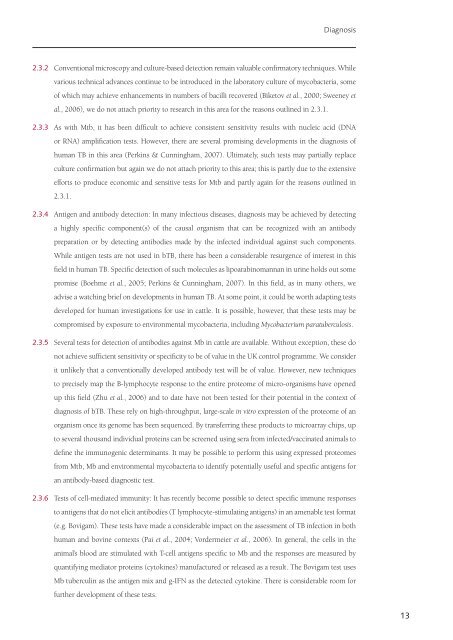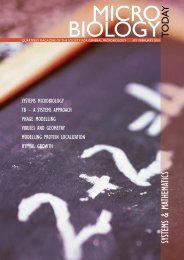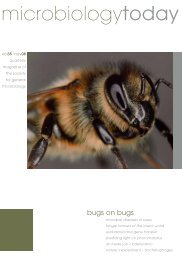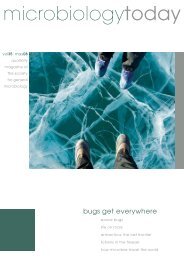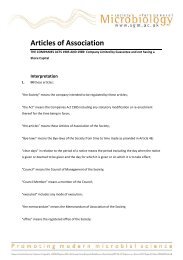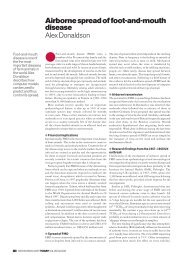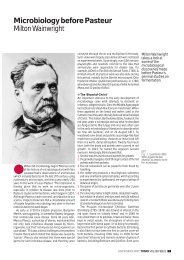final report - ARCHIVE: Defra
final report - ARCHIVE: Defra
final report - ARCHIVE: Defra
Create successful ePaper yourself
Turn your PDF publications into a flip-book with our unique Google optimized e-Paper software.
Diagnosis<br />
2.3.2 Conventional microscopy and culture-based detection remain valuable confirmatory techniques. While<br />
various technical advances continue to be introduced in the laboratory culture of mycobacteria, some<br />
of which may achieve enhancements in numbers of bacilli recovered (Biketov et al., 2000; Sweeney et<br />
al., 2006), we do not attach priority to research in this area for the reasons outlined in 2.3.1.<br />
2.3.3 As with Mtb, it has been difficult to achieve consistent sensitivity results with nucleic acid (DNA<br />
or RNA) amplification tests. However, there are several promising developments in the diagnosis of<br />
human TB in this area (Perkins & Cunningham, 2007). Ultimately, such tests may partially replace<br />
culture confirmation but again we do not attach priority to this area; this is partly due to the extensive<br />
efforts to produce economic and sensitive tests for Mtb and partly again for the reasons outlined in<br />
2.3.1.<br />
2.3.4 Antigen and antibody detection: In many infectious diseases, diagnosis may be achieved by detecting<br />
a highly specific component(s) of the causal organism that can be recognized with an antibody<br />
preparation or by detecting antibodies made by the infected individual against such components.<br />
While antigen tests are not used in bTB, there has been a considerable resurgence of interest in this<br />
field in human TB. Specific detection of such molecules as lipoarabinomannan in urine holds out some<br />
promise (Boehme et al., 2005; Perkins & Cunningham, 2007). In this field, as in many others, we<br />
advise a watching brief on developments in human TB. At some point, it could be worth adapting tests<br />
developed for human investigations for use in cattle. It is possible, however, that these tests may be<br />
compromised by exposure to environmental mycobacteria, including Mycobacterium paratuberculosis.<br />
2.3.5 Several tests for detection of antibodies against Mb in cattle are available. Without exception, these do<br />
not achieve sufficient sensitivity or specificity to be of value in the UK control programme. We consider<br />
it unlikely that a conventionally developed antibody test will be of value. However, new techniques<br />
to precisely map the B-lymphocyte response to the entire proteome of micro-organisms have opened<br />
up this field (Zhu et al., 2006) and to date have not been tested for their potential in the context of<br />
diagnosis of bTB. These rely on high-throughput, large-scale in vitro expression of the proteome of an<br />
organism once its genome has been sequenced. By transferring these products to microarray chips, up<br />
to several thousand individual proteins can be screened using sera from infected/vaccinated animals to<br />
define the immunogenic determinants. It may be possible to perform this using expressed proteomes<br />
from Mtb, Mb and environmental mycobacteria to identify potentially useful and specific antigens for<br />
an antibody-based diagnostic test.<br />
2.3.6 Tests of cell-mediated immunity: It has recently become possible to detect specific immune responses<br />
to antigens that do not elicit antibodies (T lymphocyte-stimulating antigens) in an amenable test format<br />
(e.g. Bovigam). These tests have made a considerable impact on the assessment of TB infection in both<br />
human and bovine contexts (Pai et al., 2004; Vordermeier et al., 2006). In general, the cells in the<br />
animal’s blood are stimulated with T-cell antigens specific to Mb and the responses are measured by<br />
quantifying mediator proteins (cytokines) manufactured or released as a result. The Bovigam test uses<br />
Mb tuberculin as the antigen mix and g-IFN as the detected cytokine. There is considerable room for<br />
further development of these tests.<br />
13


